You can measure fitness recovery using your sport watch by tracking resting heart rate, heart rate variability, sleep quality, and training load metrics. Your watch analyzes these physiological markers through algorithms that assess autonomic nervous system balance and cardiovascular stress levels. Key indicators include HRV trends, sleep duration and efficiency, oxygen saturation, and skin temperature measurements. While these metrics provide valuable insights, you’ll need to combine them with subjective feelings since external factors like stress, nutrition, and environmental conditions greatly impact accuracy and interpretation.
Key Physiological Metrics for Recovery Tracking
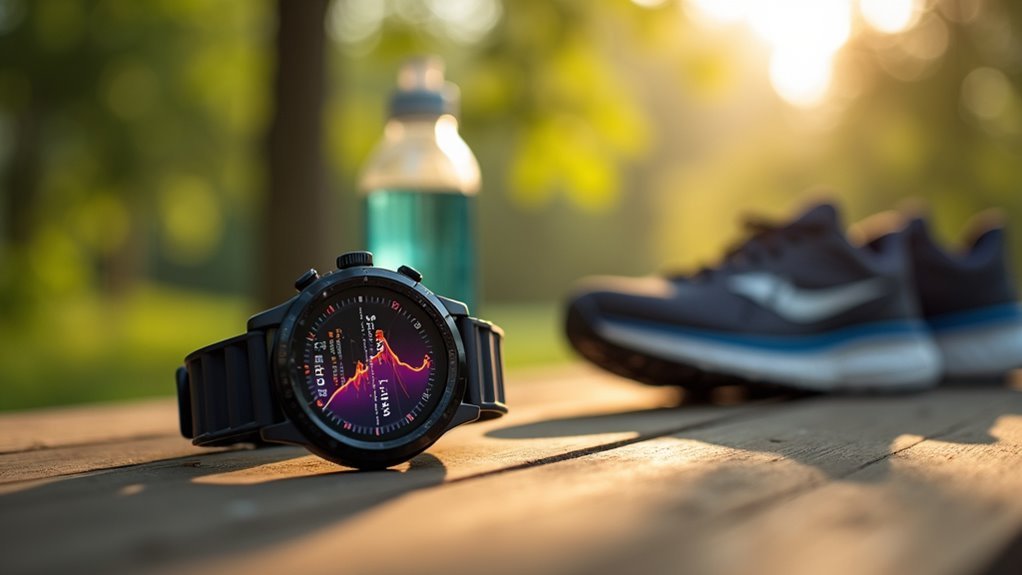
When you’re tracking recovery with a sport watch, five key physiological metrics provide the foundation for understanding how well your body has bounced back from exercise.
Your resting heart rate serves as your baseline physiological condition, revealing changes in your cardiovascular system’s stress levels.
Your resting heart rate reveals your body’s baseline stress levels and cardiovascular recovery status.
Respiratory rate monitoring during sleep and rest periods shows how efficiently your body’s recovering from training demands.
Skin temperature measurements help gauge your physiological stress levels, while oxygen saturation tracks your blood’s oxygen-carrying capacity during recovery periods.
Sleep performance data captures both quality and duration, which directly impacts your body’s ability to repair and rebuild.
These metrics work together through proprietary algorithms that analyze up to 20 different body signals, providing real-time feedback about your current recovery status and adjusting your daily exercise goals accordingly. However, recent studies reveal fundamental flaws in how these algorithms calculate training load, as duration and intensity alone don’t fully capture the true difficulty of your workouts.
Heart Rate Variability as a Recovery Indicator
Among these physiological markers, heart rate variability (HRV) stands out as one of the most revealing indicators of your body’s recovery state. HRV measures the variation in milliseconds between your heartbeats, reflecting your autonomic nervous system’s balance between parasympathetic and sympathetic activity.
When you’re properly recovered, your HRV typically rises, indicating improved adaptability and readiness for intense training. Conversely, low HRV may signal fatigue or overtraining, though interpretations vary based on your training type. Your sport watch can track this data in real-time, requiring just 2-5 minutes of measurement.
HRV responds differently to various exercise intensities—aerobic training tends to increase parasympathetic activity and boost HRV, while high-intensity sessions temporarily suppress it, helping you gauge your recovery needs. For optimal accuracy, measure HRV during morning hours when you’re most rested and relaxed.
Training Load Calculation Methods in Sport Watches
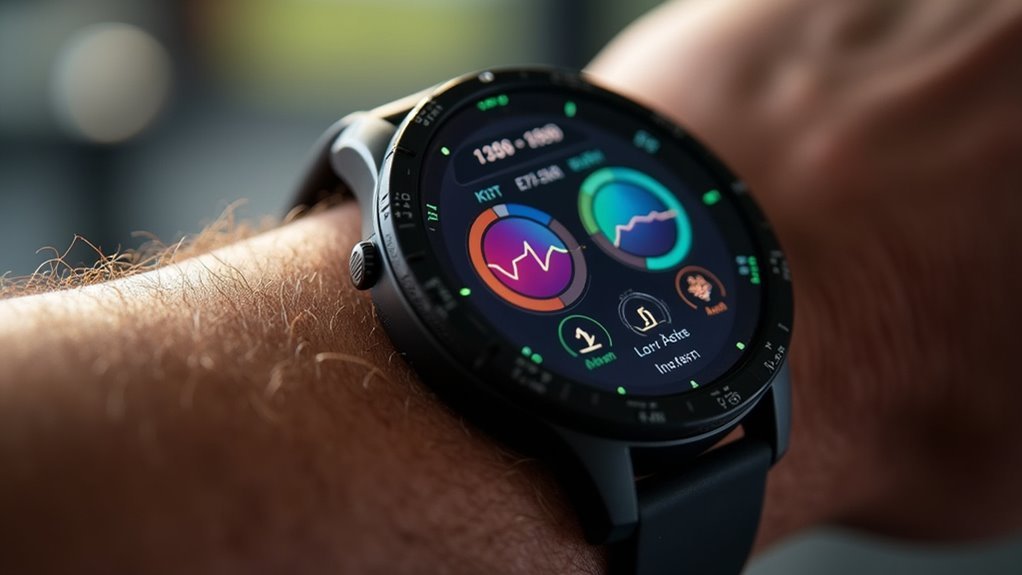
While HRV provides insights into your autonomic nervous system’s state, your sport watch calculates training load using more detailed algorithms that quantify the cumulative stress from your workouts.
The eTRIMP method weighs time spent in different heart rate zones to estimate training impulse. Garmin uses FirstBeat Technologies’ algorithms that analyze heart rate data to calculate stress scores.
Polar applies Perceived Load, combining your RPE with workout duration for a thorough assessment. Training Load Pro monitors both cardiovascular and musculoskeletal systems to provide a comprehensive view of training strain on different body systems.
Your watch estimates EPOC through algorithms since direct measurement isn’t practical. EPOC reflects the extra oxygen your body consumes post-exercise to return to baseline.
However, current methods have limitations—they don’t adequately account for your individual recovery needs, and scientists acknowledge flaws in existing algorithms that could impact training decisions.
Sleep Quality Assessment for Athletic Recovery
Beyond heart rate variability and training load calculations, your sport watch’s sleep tracking capabilities offer another essential piece of the recovery puzzle. These devices use accelerometer data and heart rate variability to estimate sleep stages and duration, though they can’t fully replicate clinical sleep studies.
| Sleep Metric | Poor Recovery | Ideal Recovery |
|---|---|---|
| Duration | <7 hours | 8-9 hours |
| Sleep Efficiency | <85% | >90% |
| REM Sleep | <15% | 20-25% |
| Deep Sleep | <10% | 15-20% |
| Wake Episodes | >5 times | <3 times |
Your watch data becomes actionable when you recognize patterns. If you’re consistently getting less than eight hours, you’re 1.7 times more likely to sustain injuries. Poor sleep quality impairs muscular strength, speed, and cognitive function—all critical for peak performance and recovery. Sleep deprivation particularly affects decision-making skills, which are crucial during competitive sports where split-second choices determine outcomes.
Resting Heart Rate Monitoring and Recovery Status
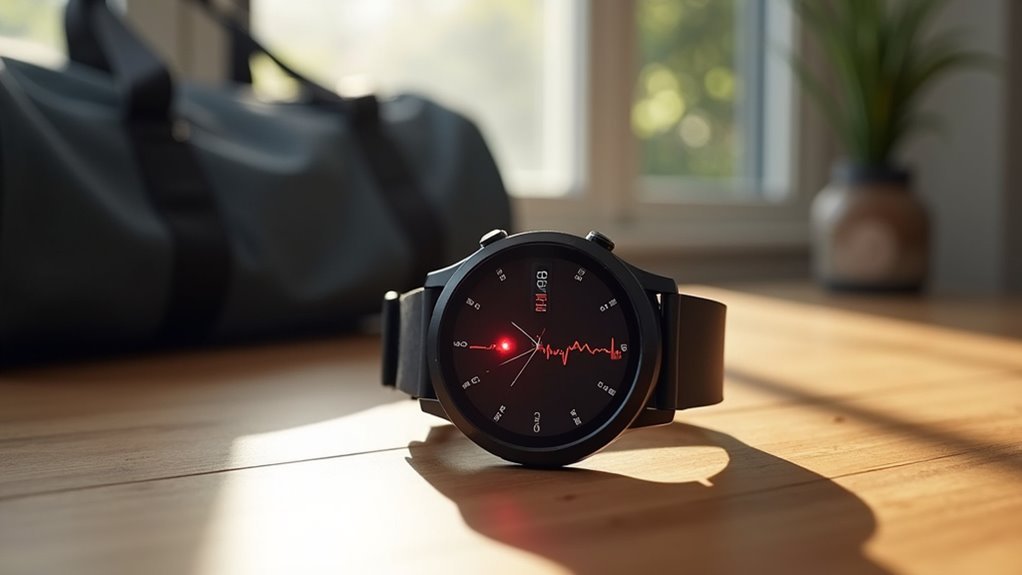
Your sport watch can establish a daily resting heart rate baseline that serves as an essential foundation for monitoring your recovery status.
When your RHR spikes above this baseline, it’s often an early warning sign that you’re overtraining, stressed, or fighting off illness. These watches can also track your heart rate recovery after workouts, which measures your heart’s ability to return to its resting pace following exercise and provides valuable insights into your cardiovascular fitness and overall health status.
Daily RHR Baseline Tracking
Since most sport watches now use photoplethysmography (PPG) technology with green LED lights to measure blood flow, they’re capable of delivering remarkably accurate resting heart rate data—with leading brands like Apple, Samsung, and Fitbit achieving 94% to 100% accuracy within ±5 bpm.
You’ll get the most reliable baseline by tracking your RHR as a long-term trend rather than focusing on isolated daily values. Measure consistently each morning after waking but before any activity, maintaining the same posture for comparable data.
Your watch’s seated RHR predictions are more useful for training guidance than raw minimum values, which often occur during sleep and can skew interpretation. Advanced models like the Polar Pacer feature Training Load Pro capabilities that analyze these heart rate patterns alongside other recovery metrics to optimize your training schedule.
This automated daily monitoring provides a practical, non-invasive method to establish your cardiovascular efficiency baseline and track fitness progression over time.
Elevated RHR Warning Signs
While your sport watch excels at establishing baseline RHR patterns, it becomes particularly valuable when detecting elevated readings that signal incomplete recovery or emerging health concerns.
Pay attention when your RHR rises unexpectedly during rest periods, as this often indicates insufficient recovery from training or overreaching. Environmental factors like temperature, altitude, and humidity can temporarily spike your readings, while lifestyle elements such as poor sleep, dehydration, or caffeine intake also influence measurements.
Watch for warning signs beyond elevated numbers: dizziness, persistent fatigue, chest pain, or abnormal breathlessness warrant immediate medical consultation. Athletes engaged in intense training may develop athlete’s heart, a benign condition that can cause structural changes resembling cardiomyopathy but typically requires no treatment.
Cross-reference your RHR data with subjective recovery markers like mood and energy levels. If elevated readings persist beyond expected recovery timeframes, adjust your training intensity and consider professional evaluation to rule out underlying cardiovascular issues.
RHR Recovery Trend Analysis
Beyond identifying warning signs, your sport watch transforms into a powerful analytical tool when you examine RHR patterns over weeks and months rather than focusing on individual daily readings. This long-term trend analysis reveals your cardiovascular fitness progression and training adaptations.
Your baseline establishment requires several weeks of consistent monitoring. Lower RHR trends over time indicate improved fitness, while consistently high or variable readings suggest chronic stress or overtraining. These patterns guide training load adjustments and recovery strategies.
| Trend Pattern | Recovery Status |
|---|---|
| Declining RHR | Improving fitness |
| Stable low RHR | Well-recovered |
| Consistently elevated RHR | Chronic stress/overtraining |
Integrate RHR data with HRV and sleep metrics for thorough recovery assessment, enabling customized training plans that prevent overreaching. Elite athletes typically demonstrate rapid heart rate recovery within the first minute following intense exercise sessions.
VO2 Max Integration in Recovery Algorithms
Your sport watch establishes a VO2 max baseline by analyzing your aerobic capacity over multiple workouts, creating a personalized fitness profile that serves as the foundation for recovery recommendations.
When your estimated VO2 max fluctuates from this baseline, the device’s algorithms interpret these changes as indicators of your current training stress and physiological state. Since VO2 max values on smartwatches are estimates, not 100% accurate measurements, these fluctuations should be viewed as general trends rather than precise physiological assessments.
The watch then adjusts your recovery time suggestions based on whether you’re operating above or below your established fitness level, ensuring your training load matches your body’s current capacity.
VO2 Max Baseline Establishment
How does your sport watch determine your personal VO2 Max baseline to power its recovery algorithms? Your device needs sufficient data collection before it can establish an accurate baseline.
This foundational measurement becomes the reference point for all subsequent recovery recommendations and training adjustments.
For Apple Watch users, you’ll need at least one previous VO2 Max estimate from 28 days prior, plus regular outdoor walks exceeding 5.75 minutes.
Garmin users must complete enough activities where the watch can combine heart rate data with pace or power metrics. Different brands utilize varying algorithms that influence how your VO2 Max calculations are processed and interpreted.
Once established, this baseline enables your watch to assess current fitness levels against your personal standard.
- Data Collection Period: Minimum 28 days of activity history required
- Activity Requirements: Regular outdoor workouts with heart rate monitoring
- Metric Integration: Combines heart rate, pace, and power data
- Personalized Assessment: Tailors recovery recommendations to your fitness level
Fitness Level Recovery Adjustment
Once your sport watch establishes your VO2 Max baseline, it begins integrating this data into sophisticated recovery algorithms that adjust recommendations based on your specific fitness level.
Your watch personalizes recovery metrics by using your individual VO2 Max values to trigger tailored rest recommendations. It considers your performance history to predict expected recovery patterns and VO2 Max trends.
The algorithms dynamically adjust your recovery windows—if you’ve got higher fitness levels, you’ll receive different rest periods between sessions compared to beginners. Since VO2 max serves as a key predictor of longevity and overall health outcomes, these recovery adjustments become increasingly important for maintaining optimal cardiovascular fitness over time.
Your watch also adapts future training loads by adjusting workout intensity and volume based on your VO2 Max and heart rate recovery data. This integration provides early warning signs for overtraining, detecting insufficient recovery before performance declines occur.
Recovery Time Estimation Techniques
When modern sport watches calculate your recovery time, they rely on sophisticated algorithms that analyze multiple data streams to estimate how long your body needs before it’s ready for another intense workout.
These devices continuously process your workout intensity, duration, and real-time physiological markers like heart rate variability, sleep quality, and stress levels. Your watch builds a personalized recovery profile using your training history and current fitness level as weighted factors.
The algorithms distinguish between different activity intensities, adjusting recovery recommendations accordingly. If you’ve got remaining recovery time from previous sessions, that’s factored into new estimates. Your watch also considers recent performance metrics and whether workouts exceeded or fell short of your fitness capabilities. However, these recovery metrics should serve as guidelines rather than absolute directives for your training decisions.
- Real-time data fusion combines sleep, stress, and HRV measurements for accurate estimates
- Personalized algorithms adapt based on your unique training history and fitness progression
- Intensity-specific calculations provide different recovery times for low, moderate, and high-effort activities
- Continuous adjustment accounts for overlapping recovery periods from multiple workout sessions
Training Status Classification Systems
While your sport watch continuously monitors recovery metrics, it’s simultaneously running sophisticated classification systems that categorize your current training status to provide an extensive view of your fitness progression.
These systems require one to two weeks of workout data, including VO2 max measurements, to establish accurate baselines and classify your conditioning as productive, maintaining, peaking, detraining, or unproductive.
Machine learning algorithms analyze heart rate variability, training load, and biomechanical data from your wrist sensors to distinguish valid exercise from poor form.
Your watch integrates data across multiple devices through cloud synchronization, accounting for environmental factors like heat and altitude. Altitude corrections are automatically applied when training at elevations above 800 meters to ensure accurate performance measurements.
This unified approach reduces data fragmentation while continuously updating your status, enabling smarter recovery recommendations and predictive training adaptations.
Combining Multiple Metrics for Comprehensive Recovery Analysis
Beyond understanding your training status classification, your sport watch’s true power emerges when it combines multiple recovery metrics into a unified analysis framework.
Your device integrates heart rate variability, sleep quality, resting heart rate, and training load data to create thorough readiness scores that guide your daily training decisions.
This multifactorial approach provides deeper insights than analyzing individual metrics separately. You’ll receive actionable recovery assessments that help prevent overtraining and optimize performance timing.
Advanced sensors measuring skin temperature and blood oxygen saturation further enhance these algorithms’ accuracy. The consistency of heart rate tracking serves as the foundation for all other metrics, ensuring reliable trends in your recovery data.
- HRV + Sleep Data – Combines autonomic nervous system markers with sleep quality for complete recovery profiling
- Training Load Correlation – Balances recent workout intensity against physiological recovery indicators
- Composite Readiness Scores – Simplifies complex data into clear training recommendations
- Injury Prevention Analytics – Predicts overreaching risk through multi-metric trending
Algorithm Limitations and Accuracy Challenges
You’ll encounter significant transparency barriers when fitness trackers use proprietary algorithms that don’t reveal how they calculate your recovery metrics.
Your device’s sensors can produce varying accuracy levels depending on factors like skin tone, tattoos, or how tightly you wear the watch.
Most algorithms also exclude essential external factors like your stress levels, sleep quality, and nutrition habits that directly impact your actual recovery needs. Research shows these devices frequently overestimate calorie burn by 27% to 93%, making their recovery calculations questionable.
Proprietary Algorithm Transparency Issues
Although fitness recovery metrics promise personalized insights, the proprietary algorithms powering your sport watch operate as black boxes that manufacturers rarely open for scrutiny.
You’ll find that companies don’t disclose their calculation methods or underlying data, making independent validation nearly impossible. This secrecy prevents third-party researchers from conducting robust accuracy testing, which undermines scientific confidence in your device’s metrics.
The lack of transparency creates several critical issues:
- You can’t verify if your recovery data is actually accurate
- Researchers can’t improve algorithms through peer review
- Innovation stagnates without open collaboration
- Algorithm biases remain hidden from users
Without access to core algorithms, you’re fundamentally trusting unverified proprietary systems with your fitness decisions, potentially slowing market-wide improvements. Personal experiences consistently show that subjective feelings may contradict what your tracker displays, highlighting the disconnect between algorithmic predictions and actual recovery states.
External Factor Exclusions
When your sport watch calculates recovery metrics, it’s measuring physiological markers like heart rate variability and sleep patterns while completely ignoring the external factors that greatly influence how you actually feel and perform.
Your watch can’t account for work stress, poor nutrition, or that late night you had. It doesn’t know you’re dehydrated or dealing with relationship issues. These algorithms oversimplify complex human recovery by focusing on limited data points while excluding essential lifestyle variables.
| Factor Tracked | Factor Ignored |
|---|---|
| Heart rate variability | Work stress levels |
| Sleep duration | Nutrition quality |
| Resting heart rate | Hydration status |
| Movement patterns | Life events impact |
This creates a disconnect between your watch’s recovery score and how you genuinely feel, potentially leading to training decisions based on incomplete information. The key is remembering that data should guide, not dictate your recovery and training choices.
Sensor Accuracy Variations
Beyond these excluded variables lies another fundamental problem: the sensors themselves don’t always capture accurate data. Your sport watch’s optical HR sensor struggles with skin contact quality, motion artifacts, and ambient light interference.
Accuracy drops dramatically during high-intensity exercise when you need reliable data most. Different manufacturers use varying sensor hardware and proprietary algorithms, creating significant inter-device variability in readings.
Your device’s performance degrades significantly at heart rates above 150 bpm, where recovery calculations become critical. Algorithm updates can alter accuracy unexpectedly, while motion artifacts from dynamic activities often corrupt readings entirely. Sleep tracking presents additional challenges since devices have limited capabilities in distinguishing between different light sleep stages accurately.
Key accuracy challenges you’ll encounter:
- Hardware limitations – Cheaper sensors provide less reliable data
- Algorithm variability – Brands interpret raw data differently
- Motion interference – High-impact activities corrupt sensor readings
- Range-specific errors – Accuracy drops at higher heart rates
External Factors Affecting Recovery Measurements
Since your sport watch relies on various sensors and algorithms to calculate recovery metrics, numerous external factors can greatly influence the accuracy and reliability of these measurements.
Environmental conditions considerably impact your recovery data. High altitude reduces oxygen availability, affecting your heart rate variability readings. Climate changes stress your body’s adaptation systems, skewing recovery calculations. Travel and jetlag disrupt your circadian rhythms, making sleep-based recovery metrics less reliable.
| Factor | Impact on Recovery Measurements |
|---|---|
| High Altitude | Affects HRV and oxygen saturation readings |
| Hot Climate | Elevates resting heart rate artificially |
| Travel/Jetlag | Disrupts sleep quality metrics |
| Work Stress | Increases baseline stress indicators |
| Social Pressure | Affects psychological recovery markers |
Your watch can’t distinguish between physical fatigue and external stressors, so you’ll need to interpret recovery data within context of your environment and lifestyle factors. Recovery markers can remain elevated for up to 72 hours after intense physical activity, making it important to account for recent training sessions when evaluating your current recovery status.
Personalizing Recovery Recommendations Based on Fitness Level
Understanding these environmental influences sets the foundation for the next critical step: tailoring recovery recommendations to match your specific fitness level.
Your sport watch doesn’t just collect data—it analyzes your unique patterns to create personalized recovery strategies. Machine learning algorithms assess your fitness baseline, track your progress, and adapt recommendations as you improve. The system considers your age, health conditions, and biomechanical patterns to prevent injuries and optimize performance.
Your watch continuously refines its understanding of your body’s responses, creating increasingly accurate recovery protocols. Advanced algorithms also monitor your sleep patterns to provide comprehensive recovery insights that factor in rest quality alongside physical metrics. This personalized approach guarantees you’re neither overtraining nor underutilizing your potential.
- Adaptive training programs adjust intensity based on your current fitness level and recovery status
- Real-time feedback guides workout modifications during exercise sessions
- Injury risk analysis identifies movement patterns that could lead to problems
- Dynamic goal setting evolves targets as your fitness improves
Practical Training Applications Using Recovery Data
When your sport watch delivers personalized recovery insights, the real value emerges through strategic application in your training routine.
The true power of recovery insights lies not in the data itself, but in how strategically you apply them to transform your training.
You’ll use recovery data to adjust training intensity, preventing overtraining while optimizing performance gains. Monitor metrics like heart rate recovery and intensity trends to assess your training readiness before high-performance sessions.
Your recovery data becomes an early warning system for injury prevention, identifying concerning patterns before they become problems.
You can evaluate training load impact, ensuring your sessions align with your body’s adaptation capacity. Recovery timers guide your scheduling decisions, while load assessment helps balance stress and rest. Remember that recovery recommendations can be overly cautious, so combine device insights with how your body actually feels to make informed training decisions.
Frequently Asked Questions
How Much Do Sport Watches With Recovery Tracking Typically Cost?
You’ll find sport watches with recovery tracking ranging from $150-$300 for entry-level models, $300-$700 for mid-range options, and $700-$1,200 for premium watches with elite features.
Which Sport Watch Brands Offer the Most Accurate Recovery Measurements?
You’ll find Garmin, Samsung Galaxy Watch 7, and Whoop offer the most accurate recovery measurements. Garmin provides balanced HRV readings, Samsung has FDA-cleared algorithms, while Whoop excels in detailed recovery analytics.
How Long Does It Take to See Meaningful Recovery Trends?
You’ll start seeing meaningful recovery trends after consistently tracking your data for several weeks to months. Your watch needs time to establish baseline patterns and account for your individual fitness level and workout variations.
Can Recovery Metrics Help Prevent Sports Injuries Effectively?
You can effectively prevent sports injuries using recovery metrics. They’ll help you identify overtraining early, optimize your training loads, and make data-driven decisions about when you’re ready for intense workouts.
Do Recovery Features Work Equally Well for All Types of Sports?
Recovery features don’t work equally well across all sports. You’ll find they’re optimized for endurance activities like running and cycling, but they’re less accurate for team sports, weightlifting, or activities with intermittent intensity patterns.
In Summary
You’ll find that recovery metrics from sport watches aren’t perfect, but they’re valuable tools when you understand their limitations. Don’t rely solely on the data—you’ll need to reflect on how you actually feel and adjust accordingly. Start by tracking basic metrics like HRV and sleep quality, then gradually incorporate more advanced features. Remember, you’re unique, so what works for other athletes won’t necessarily work for you.

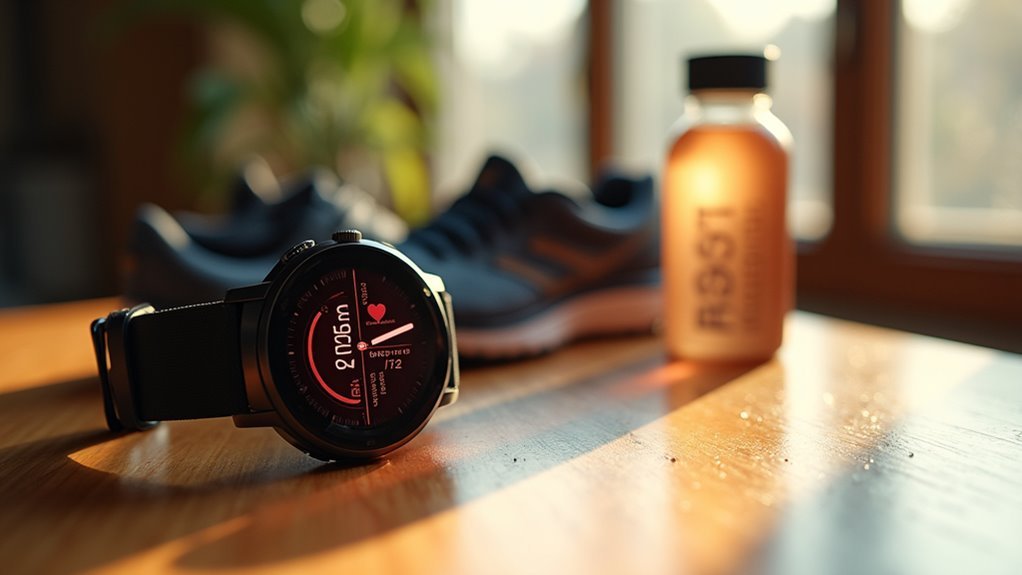
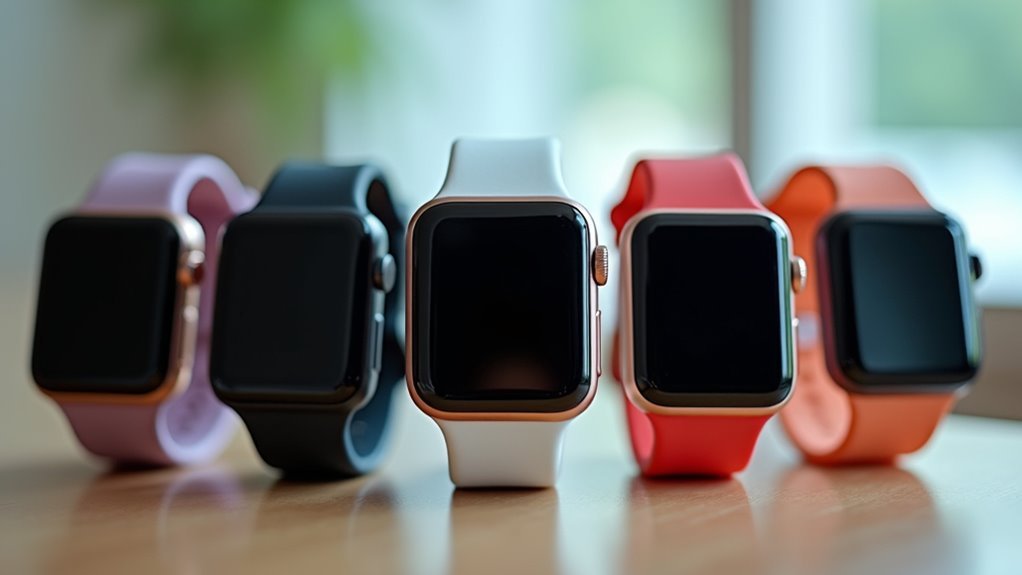
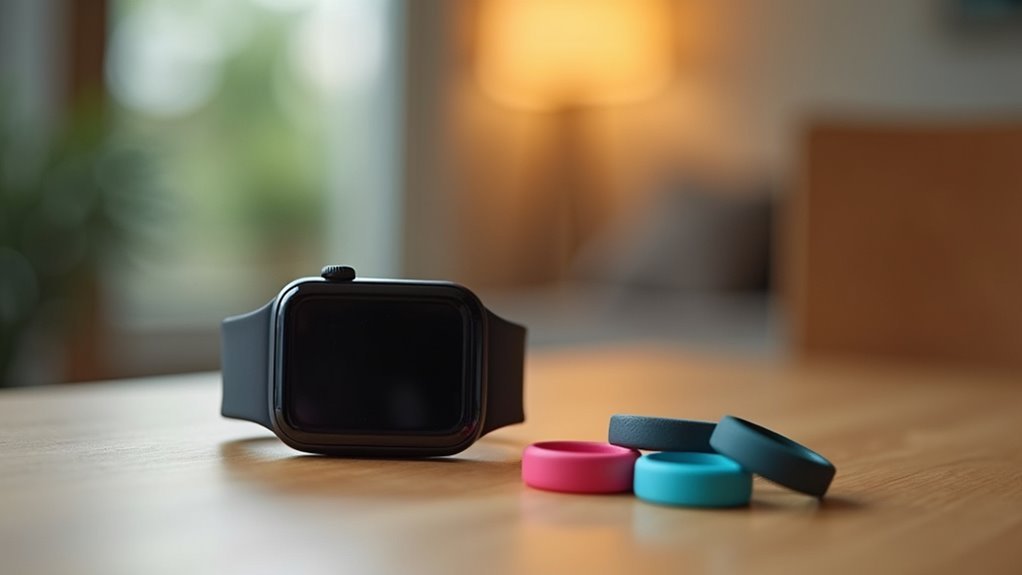
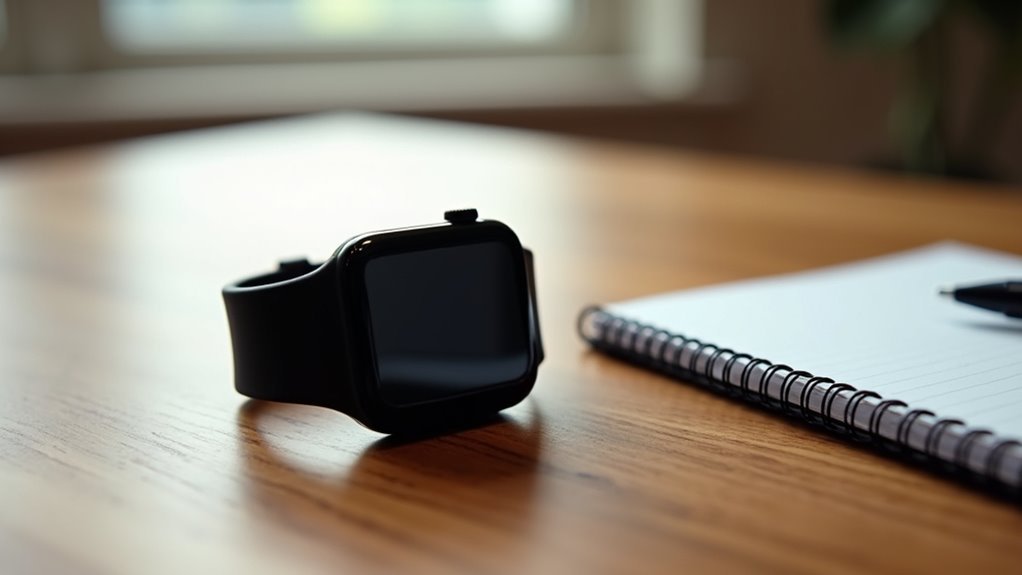
Leave a Reply